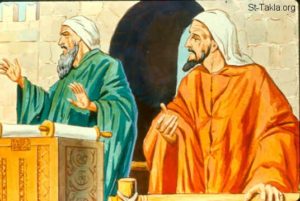The Rabbinic Period, Returning, the Land of Israel as a Focus in Jewish History, Benjamin J. Segal, World Zionist Organization, Jerusalem 1987.
 In the fifth century B.C.E., Ezra and Nehemiah reestablished a spiritual and political base for the fledgling community which had returned to Israel from the Babylonian exile. For more than a thousand years there-following, the Jews would engage in reinterpretation and redefinition of their culture. By the time those centuries had passed, all the basic concepts of post-Biblical Judaism were set. They remained basically unchanged until the nineteenth century.
In the fifth century B.C.E., Ezra and Nehemiah reestablished a spiritual and political base for the fledgling community which had returned to Israel from the Babylonian exile. For more than a thousand years there-following, the Jews would engage in reinterpretation and redefinition of their culture. By the time those centuries had passed, all the basic concepts of post-Biblical Judaism were set. They remained basically unchanged until the nineteenth century.
Judaism even as we know it today is primarily the rabbinic Judaism formed during that period. The millennium which witnessed this growth was marked by a new type of leader and a unique collection of literature. At the same time, the political history of the period was in constant flux.
The new leaders were the rabbis. Scholarship was the basis of their position and they saw themselves primarily as students and teachers, interpreters of the tradition as it was handed down. Unlike the Biblical priests, the rabbis inherited neither title nor glory. Each student had to earn the title “rabbi,” which was granted only after much study and proof of knowledge, acumen and understanding. Unlike the Biblical prophets, who were understood to be inspired individuals, the rabbis banded together in a group leadership centered in the academies. Outstanding individuals of course gained prominence among their colleagues, but the foremost characteristic of the age was the excitement of deliberation, and the great challenge of the period was interpretation- understanding and refining the differences of approach and of substance while maintaining a workable, unified system.
The literature which preserves the essence of those years of learning and deliberation is the Talmud. In its two sections (the Mishna—collected statements edited circa 200 C.E.; and the much longer Gemara—collected statements completed in the fifth-sixth centuries) one finds an ever fascinating mixture of law, lore, beliefs, practices, customs, ideas, and ideals of those times. Additional material from the mouths of these same rabbis is found in the early Midrashim (singular, “Midrash”)— collections of primarily homiletical material based on the Biblical text.
While rabbinic leadership and literature demonstrate coherence and cohesiveness, the political history of that millennium is extremely diverse. Although the first exile ended in 537 B.C.E., the Jews never all returned to Israel. The Diaspora, the Jewish dispersion, was a fact. Indeed, even within Israel the periods of actual Jewish control of the Land were few. A brief period of independence and power began with the Hasmonean dynasty in the mid-second century B.C.E. However, from Pompei’s conquest of the Middle East in the mid-first century B.C.E., Rome held effective political control, and all pretense of independence was lost with the destruction of the Second Temple in 70 C.E. The messianically oriented Jewish revolt of 132 C.E. was crushed in just over three years.
Culturally, isolation was nonexistent. Given the political circumstances, Judaism had to struggle with varied cultural influences, first Greek and then Roman. Demographically, too, a basic change was taking place. Gradually, the numerical center of the Jewish people shifted from Israel to Babylonia. Perhaps more important, as the period ended, the intellectual center also moved with the people, away from the land.
This was a millennium more basic to the formation of Judaism as we now know it than the Biblical era. The rabbinic period began with the reestablished presence of the Jews in Israel after the first exile, and ended with the reestablished centrality of the Diaspora. The central event—the destruction of the second Temple and the beginning of the second exile, which would last nearly two thousand years—naturally forms the focus of concern about the Land. It is to that millennium, to that literature and to those rabbis that we now turn to continue tracing the relationship of the people and the Land of Israel.
The Rabbinic Period—A Chronology
BEFORE COMMON ERA
-333 Alexander the Great’s conquest of mid-east.
-166 Successful Hasmonean rebellion against Syrian domination and oppression.
-165 to -65 Century of Hasmonean rule, including brief period of military domination over entire area.
-63 Beginning of Roman domination (Pompei conquers Temple Mount).
-37 to -4 Reign of Herod as “king” (under Rome), including massive rebuilding of the Temple Mount, 19 B.C.E.
COMMON ERA
66 C.E. Beginning of the great revolt against Rome.
70 Seige of Jerusalem, destruction of the Temple.
132 to 135 Revolt led by Bar Kokhba. Brief independence. Following defeat, Jews are barred from Jerusalem.
c. 210 Redaction of the Mishna.
220 to 260 Founding of the leading academies in Babylonia.
c. 390 Completion of the Palestinian Talmud.
425 Patriarchate in Israel abolished.
c. 500 Completion of the Babylonian Talmud



